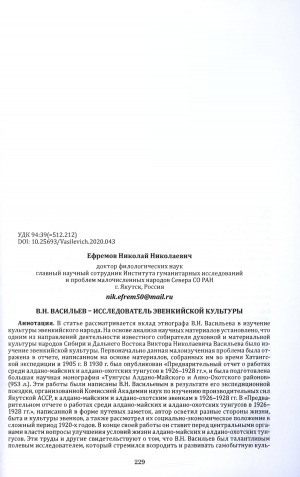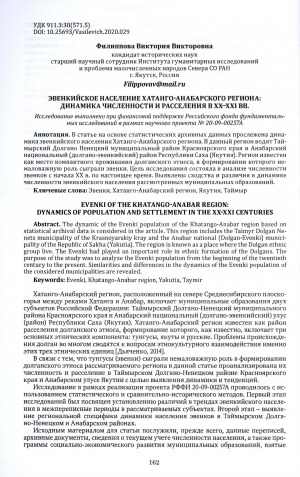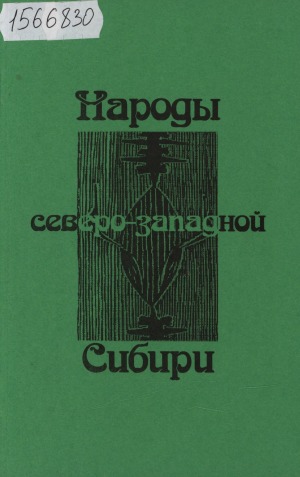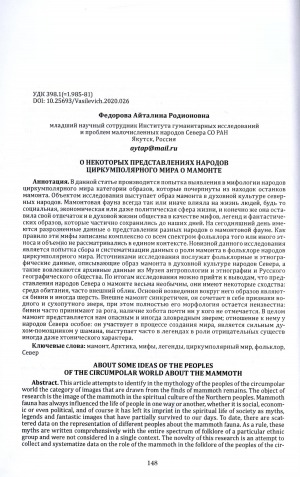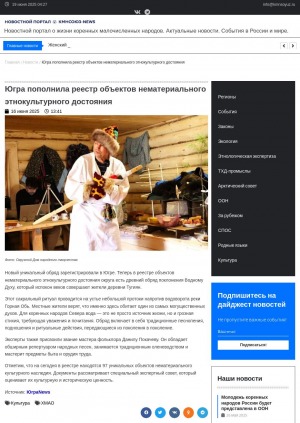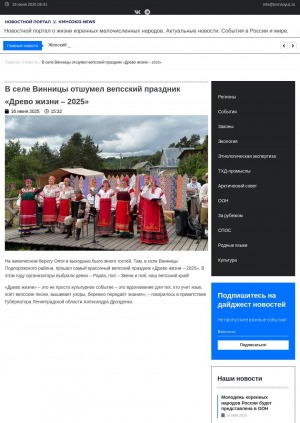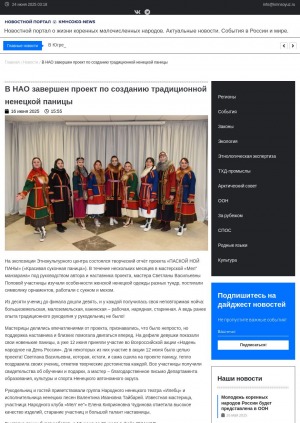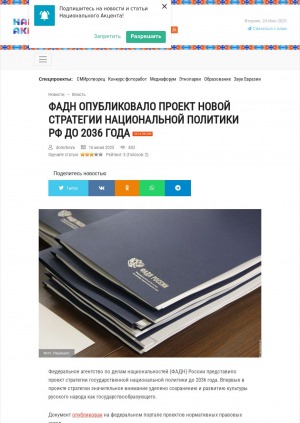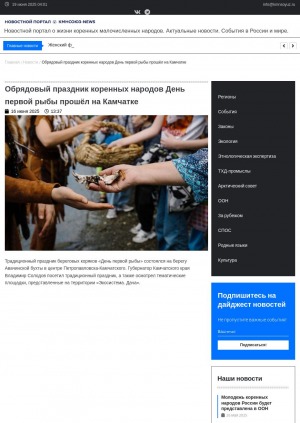- Книга (1379)
- Журнал (8)
- Автореферат диссертации (65)
- Изоиздание (36)
- Аудиоиздание (27)
- Видеоиздание (84)
- Неопубликованный документ (3)
- Нотное издание (3)
- Фотография (12)
- Статья (431)
- Библиографический указатель (15)
- Словарь (2)
- Календарь (1)
- Брошюра (27)
- Буклет (13)
- Электронное издание (2)
- 3D-модель (24)
- Грампластинка (5)
- Веб-архив (494)
Количество страниц: 6 с.
The article considers the contribution of ethnographer V.N. Vasiliev to the study of the Evenki people. Based on the analysis of scientific and archival materials, it was established that one of the main areas of research of the famous collector of the spiritual and material culture of the peoples of Siberia and the Far East Viktor Nikolayevich Vasiliev was the coverage of Evenki culture. Initially, this little-studied problem was reflected by him in a report written on the basis of materials that were collected during the Hatang expedition in 1905. In 1930 he published the scientific work “Preliminary Report on Works among the Aldano-May and Aldano-Okhotsk Tungus in 1926-1928” and a large scientific monograph was prepared "Tunguses of Aldan-Maisky and Ayano-Okhotsk regions” (953 1.), In which a description was given of the Aldano-May Evenks and the Aldano-Okhotsk Evenks from a cultural, socio-economic point of view. These works were written in V.N. Vasiliev as a result of his expeditionary trip of 1926-1928, organized by the Commission of the Academy of Sciences for the Study of Productive Yakut Autonomous Soviet Socialist Republic, Aldano-May and Aldano-Okhotsk Evenks. The manuscript of Vasiliev’s monograph has not yet been published. In the "Preliminary Report on Works among the Aldano-May and Aldano-Okhotsk Tungus in 1926-1928”, written in the form of travel notes, the author highlighted different aspects oflife, life and culture of the Evenks, and also examined their socio-economic situations in a difficult period of 20. 20. At the end of his work, he raises with the central authority's questions of improving the living conditions of the Aldano-May and Aldano-Okhotsk Tungus. These works and others indicate that V.N. Vasiliev was a talented field researcher who sought to revive and develop the original culture of the Evenks and other peoples of Siberia and the Far East. The deep and comprehensive study of the culture of the peoples of Siberia and the Far East V.N. Vasiliev was due to the fact that Viktor Nikolaevich himself was born and grew up in the multicultural environment of Yakutia, where representatives of different nationalities closely contacted each other materially and spiritually, overcoming the harsh conditions of the northern region.
Количество страниц: 5 с.
- 1. Народы и культуры Северной Азии в контексте научного наследия Г. М. Василевич: сборник научных статей, 2020
- 2. Слепцова Айталина Алексеевна. Изделия из кости в якутских погребениях = Bone products in yakut burials
- 3. Федорова Айталина Родионовна. О некоторых представлениях народов циркумполярного мира о мамонте = About some ideas of the peoples of the circumpolar world about the mammoth
- 4. Яковлева Капитолина Максимовна, Михайлова Саргылана Михайловна. Растительный орнамент в якутских украшениях: красота со смыслом = Floral ornament in yakut jewelry: beauty with meaning
- 5. Санникова Яна Михайловна. Традиционные хозяйственные занятия коренного населения Анабарского региона Якутии на рубеже XX - XXI вв. в контексте исследования культурного ландшафта = Traditional economic activity of the indigenous population of the Anabar region of Yakutia at the turn of the XX-XXI centuries in the context of cultural and landscape research
- 6. Бойтунова Светлана Иннокентьевна. Истоки книжности народов Севера (1812 - XX в.): историческая реконструкция = The origins of the bookishness of the North peoples (1812-1917): historical reconstruction
- 7. Максимова Саргылана Васильевна, Бойтунова Светлана Иннокентьевна. Культурный код этнолога Уллы Йохансен в дарственной коллекции Национальной библиотеке Республики Саха (Якутия) = Ethnologist Ulla Johansen's cultural code in the donation collection of the National library of the Republic of Sakha (Yakutia)
- 8. Петров Пантелеймон Пантелеймонович. Загадочная "Земля якутского дворянина": история одной карты Северо-Востока Азии и Аляски (XVIII в.) = Mysterious “Land of the yakut nobleman": the history of a map of Northeast Asia and Alaska (XVIII centure)
- 9. Курилов Гаврил Николаевич. Отражение в языке юкагиров одной из древних культурных традиций = Language in the disclosure of one of the cultural traditions of the ancient yukagirs
- 10. Дьячковский Федор Николаевич. Семантическое освоение якутских слов в говорах эвенков Якутии (на материале "Эвенкийско-русского словаря" А. Н. Мыреевой) = Semantic adaptation of yakut words in evenki dialects in Yakutia (illustrated by A.N. Myreeva's Evenki-Russian Dictionary)
- 11. Николаев Егор Револьевич. О тунгусо-маньчжурских заимствованиях в лексико-тематической группе "Пища" в якутском языке (по лексикографическим материалам) = On the tungus-manchu borrowings of the lexical-thematic group "Food" in the yakut language (based on lexicographic materials)
Филиппова, В. В.
Эвенкийское население Хатанго-Анабарского региона: динамика численности и расселения в XX-XXI вв. / Филиппова В. В. ; Институт гуманитарных исследований и проблем малочисленных народов Севера СО РАН // Народы и культуры Северной Азии в контексте научного наследия Г. М. Василевич : сборник научных статей / ответственный редактор Л. И. Миссонова ; редакционная коллегия: А. Н. Варламов, Н. И. Данилова, Е. Г. Маклашова [и др.] ; рецензенты: Т. В. Аргунова, Т. Г. Басангова, В. Н. Давыдов ; ответственный за выпуск М. П. Дьяконова. - Якутск : ИГИиПМНС СО РАН, 2020. - С. 162-166. - DOI: 10.25693/Vasilevich.2020.029
DOI: 10.25693/Vasilevich.2020.029
Издательство: Томского университета
Год выпуска: 1996
Серия, номер выпуска: Вып. 3
Количество страниц: 84 с.
Количество страниц: 6 с.
- 1. Народы и культуры Северной Азии в контексте научного наследия Г. М. Василевич: сборник научных статей, 2020
- 2. Слепцова Айталина Алексеевна. Изделия из кости в якутских погребениях = Bone products in yakut burials
- 3. Федорова Айталина Родионовна. О некоторых представлениях народов циркумполярного мира о мамонте = About some ideas of the peoples of the circumpolar world about the mammoth
- 4. Филиппова Виктория Викторовна. Эвенкийское население Хатанго-Анабарского региона: динамика численности и расселения в XX-XXI вв. = Evenki of the Khatango-Anabar region: dynamics of population and settlement in the XX-XXI centuries
- 5. Санникова Яна Михайловна. Традиционные хозяйственные занятия коренного населения Анабарского региона Якутии на рубеже XX - XXI вв. в контексте исследования культурного ландшафта = Traditional economic activity of the indigenous population of the Anabar region of Yakutia at the turn of the XX-XXI centuries in the context of cultural and landscape research
- 6. Бойтунова Светлана Иннокентьевна. Истоки книжности народов Севера (1812 - XX в.): историческая реконструкция = The origins of the bookishness of the North peoples (1812-1917): historical reconstruction
- 7. Максимова Саргылана Васильевна, Бойтунова Светлана Иннокентьевна. Культурный код этнолога Уллы Йохансен в дарственной коллекции Национальной библиотеке Республики Саха (Якутия) = Ethnologist Ulla Johansen's cultural code in the donation collection of the National library of the Republic of Sakha (Yakutia)
- 8. Петров Пантелеймон Пантелеймонович. Загадочная "Земля якутского дворянина": история одной карты Северо-Востока Азии и Аляски (XVIII в.) = Mysterious “Land of the yakut nobleman": the history of a map of Northeast Asia and Alaska (XVIII centure)
- 9. Курилов Гаврил Николаевич. Отражение в языке юкагиров одной из древних культурных традиций = Language in the disclosure of one of the cultural traditions of the ancient yukagirs
- 10. Дьячковский Федор Николаевич. Семантическое освоение якутских слов в говорах эвенков Якутии (на материале "Эвенкийско-русского словаря" А. Н. Мыреевой) = Semantic adaptation of yakut words in evenki dialects in Yakutia (illustrated by A.N. Myreeva's Evenki-Russian Dictionary)
- 11. Николаев Егор Револьевич. О тунгусо-маньчжурских заимствованиях в лексико-тематической группе "Пища" в якутском языке (по лексикографическим материалам) = On the tungus-manchu borrowings of the lexical-thematic group "Food" in the yakut language (based on lexicographic materials)
This article attempts to identify in the mythology of the peoples of the circumpolar world the category of images that are drawn from the finds of mammoth remains. The object of research is the image of the mammoth in the spiritual culture of the Northern peoples. Mammoth fauna has always influenced the life of people in one way or another, whether it is social, economic or even political, and of course it has left its imprint in the spiritual life of society as myths, legends and fantastic images that have partially survived to our days. To date, there are scattered data on the representation of different peoples about the mammoth fauna. As a rule, these myths are written comprehensively with the entire spectrum of folklore of a particular ethnic group and were not considered in a single context. The novelty of this research is an attempt to collect and systematize data on the role of the mammoth in the folklore of the peoples of the cir cumpolar world. The research sources are folklore and ethnographic data describing the image of the mammoth in the spiritual culture of the peoples of the North, as well as archival data from the Museum of anthropology and Ethnography and the Russian geographical society. According to the results of the study, it can be concluded that the ideas of the peoples of the North about the mammoth are very unusual, they have some similarities: the habitat, often the appearance. The basis for the construction of images around it are tusks and sometimes wool. Externally, the mammoth is syncretic, it combines the characteristics of an aquatic and land animal, while its morphology remains completely unknown, tusks are often mistaken for horns, and the presence of a trunk is almost never noted. In General, the mammoth seems to us a dangerous and sometimes malicious beast, the attitude to it among the peoples of the North is special, it participates in the process of creating the world, is a strong spirit-assistant to the shaman, often acts in legends as negative beings, sometimes even of a chthonic nature.
Яковлева, К. М.
Растительный орнамент в якутских украшениях: красота со смыслом / Яковлева М. К., Михайлова С. М. ; Северо-Восточный федеральный университет им. М. К. Аммосова // Народы и культуры Северной Азии в контексте научного наследия Г. М. Василевич : сборник научных статей / ответственный редактор Л. И. Миссонова ; редакционная коллегия: А. Н. Варламов, Н. И. Данилова, Е. Г. Маклашова [и др.] ; рецензенты: Т. В. Аргунова, Т. Г. Басангова, В. Н. Давыдов ; ответственный за выпуск М. П. Дьяконова. - Якутск : ИГИиПМНС СО РАН, 2020. - С. 152-157. - DOI: 10.25693/Vasilevich.2020.027
DOI: 10.25693/Vasilevich.2020.027
Количество страниц: 5 с.
- 1. Народы и культуры Северной Азии в контексте научного наследия Г. М. Василевич: сборник научных статей, 2020
- 2. Слепцова Айталина Алексеевна. Изделия из кости в якутских погребениях = Bone products in yakut burials
- 3. Яковлева Капитолина Максимовна, Михайлова Саргылана Михайловна. Растительный орнамент в якутских украшениях: красота со смыслом = Floral ornament in yakut jewelry: beauty with meaning
- 4. Филиппова Виктория Викторовна. Эвенкийское население Хатанго-Анабарского региона: динамика численности и расселения в XX-XXI вв. = Evenki of the Khatango-Anabar region: dynamics of population and settlement in the XX-XXI centuries
- 5. Санникова Яна Михайловна. Традиционные хозяйственные занятия коренного населения Анабарского региона Якутии на рубеже XX - XXI вв. в контексте исследования культурного ландшафта = Traditional economic activity of the indigenous population of the Anabar region of Yakutia at the turn of the XX-XXI centuries in the context of cultural and landscape research
- 6. Бойтунова Светлана Иннокентьевна. Истоки книжности народов Севера (1812 - XX в.): историческая реконструкция = The origins of the bookishness of the North peoples (1812-1917): historical reconstruction
- 7. Максимова Саргылана Васильевна, Бойтунова Светлана Иннокентьевна. Культурный код этнолога Уллы Йохансен в дарственной коллекции Национальной библиотеке Республики Саха (Якутия) = Ethnologist Ulla Johansen's cultural code in the donation collection of the National library of the Republic of Sakha (Yakutia)
- 8. Петров Пантелеймон Пантелеймонович. Загадочная "Земля якутского дворянина": история одной карты Северо-Востока Азии и Аляски (XVIII в.) = Mysterious “Land of the yakut nobleman": the history of a map of Northeast Asia and Alaska (XVIII centure)
- 9. Курилов Гаврил Николаевич. Отражение в языке юкагиров одной из древних культурных традиций = Language in the disclosure of one of the cultural traditions of the ancient yukagirs
- 10. Дьячковский Федор Николаевич. Семантическое освоение якутских слов в говорах эвенков Якутии (на материале "Эвенкийско-русского словаря" А. Н. Мыреевой) = Semantic adaptation of yakut words in evenki dialects in Yakutia (illustrated by A.N. Myreeva's Evenki-Russian Dictionary)
- 11. Николаев Егор Револьевич. О тунгусо-маньчжурских заимствованиях в лексико-тематической группе "Пища" в якутском языке (по лексикографическим материалам) = On the tungus-manchu borrowings of the lexical-thematic group "Food" in the yakut language (based on lexicographic materials)
This article attempts to identify in the mythology of the peoples of the circumpolar world the category of images that are drawn from the finds of mammoth remains. The object of research is the image of the mammoth in the spiritual culture of the Northern peoples. Mammoth fauna has always influenced the life of people in one way or another, whether it is social, economic or even political, and of course it has left its imprint in the spiritual life of society as myths, legends and fantastic images that have partially survived to our days. To date, there are scattered data on the representation of different peoples about the mammoth fauna. As a rule, these myths are written comprehensively with the entire spectrum of folklore of a particular ethnic group and were not considered in a single context. The novelty of this research is an attempt to collect and systematize data on the role of the mammoth in the folklore of the peoples of the cir cumpolar world. The research sources are folklore and ethnographic data describing the image of the mammoth in the spiritual culture of the peoples of the North, as well as archival data from the Museum of anthropology and Ethnography and the Russian geographical society. According to the results of the study, it can be concluded that the ideas of the peoples of the North about the mammoth are very unusual, they have some similarities: the habitat, often the appearance. The basis for the construction of images around it are tusks and sometimes wool. Externally, the mammoth is syncretic, it combines the characteristics of an aquatic and land animal, while its morphology remains completely unknown, tusks are often mistaken for horns, and the presence of a trunk is almost never noted. In General, the mammoth seems to us a dangerous and sometimes malicious beast, the attitude to it among the peoples of the North is special, it participates in the process of creating the world, is a strong spirit-assistant to the shaman, often acts in legends as negative beings, sometimes even of a chthonic nature.
Федорова, А. Р.
О некоторых представлениях народов циркумполярного мира о мамонте / Федорова А. Р. ; Институт гуманитарных исследований и проблем малочисленных народов Севера СО РАН // Народы и культуры Северной Азии в контексте научного наследия Г. М. Василевич : сборник научных статей / ответственный редактор Л. И. Миссонова ; редакционная коллегия: А. Н. Варламов, Н. И. Данилова, Е. Г. Маклашова [и др.] ; рецензенты: Т. В. Аргунова, Т. Г. Басангова, В. Н. Давыдов ; ответственный за выпуск М. П. Дьяконова. - Якутск : ИГИиПМНС СО РАН, 2020. - С. 148-152. - DOI: 10.25693/Vasilevich.2020.026
DOI: 10.25693/Vasilevich.2020.026
Год выпуска: 2025
Год выпуска: 2025
Год выпуска: 2025
Год выпуска: 2025
Год выпуска: 2025
